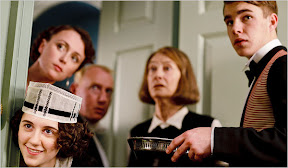
Now Available to Own
Photo Slideshow
Related Review:
Upstairs, Downstairs: 40th Anniversary Edition (Complete Series)AKA: Upstairs, Downstairs: Series 6; Upstairs, Downstairs: Christmas Special
In a daring move, thirty-five years after the last new episode of the original ITV series was broadcast in 1975, BBC and PBS Masterpiece Theater picked up the narrative thread of TV’s landmark Peabody, BAFTA, Emmy and Golden Globe award-winning smash Upstairs, Downstairs, offering fans a continuation of the storyline rather than a traditional remake of the beloved program.
And just like the eponymous series itself blends together new and old while centering on the fusion of dual worlds involving the servants below stairs and the masters above, the most recent incarnation of Upstairs, Downstairs takes a similar approach onscreen and off.
Spanning a mere three episodes, the show’s unofficial sixth season is set in 1936, exactly six years after head house maid Rose Buck (co-creator Jean Marsh) closed the door to the London Belgravia neighborhood home of 165 Eaton Place at the close of the previous collection.
And fortunately for those of us who can’t imagine Upstairs, Downstairs without its heart (Rose) as well as its soul in the form of the home that houses so much history, both Rose and Eaton Place return in the 2010 miniseries, to the credit of Cranford screenwriter Heidi Thomas.
Nonetheless, determined to avoid sentimental shortcuts or trips down memory lane beyond mere mentions of the past, although Thomas has both the heart and the soul of Upstairs, Downstairs at her disposal, she ambitiously strives to flesh out her new characters while establishing her vision for the future of Eaton Place.
Not wanting viewer nostalgia for the grand Belgravia house to overwhelm our first impression of the new owners – Sir Hallam Holland (Ed Stoppard) and his wife Lady Agnes (Keeley Hawes) – who’ve inherited the former Bellamy residence, Thomas opts for a bold, gothic approach as the young couple enter in the dead of night.
Unable to see much beyond newspapers, dust and sheets other than to note that it’s as if the whole house was still asleep, it’s a starkly anti-sentimental yet fitting way to allude to all those who’ve lived, died, loved, fought, laughed or merely walked through 165 over the course of the previous five seasons.
However, while admittedly flashbacks would’ve certainly been as out of place as old cast cameos, after Rose leaves her business coordinating domestic staff and returns to service as the Holland housekeeper, from remaining silent about Mr. Hudson to falling in line downstairs, it seems disingenuous and out-of-character for Rose not to overtly acknowledge her history in the house with others.
But perhaps in an attempt to address this onscreen and off, Thomas does offer us the next best thing at the end of the first episode as co-creators Marsh and Eileen Atkins (perfectly cast as a wacky upstairs matriarch) have an onscreen, in-character discussion which articulates how integral their experience is to the house that needs them.
Released in time to coincide with Acorn Media’s 40th Anniversary Edition box set of the original sixty-eight episodes, it goes without saying that technologically speaking, the series has come a long way from the bright key-lighting and static camera shots evident in the ‘70s production.
However, there’s something about the UK to US region switch and the overall presentation that’s ultimately better suited to DVD rather than Blu-ray technology, if you’ve picked up the gorgeously packaged two-disc set.
For similar to the stilted stop-start fluidity of the image transfer and slightly jumpy visual quality on display in a few other BBC on DVD productions including Life on Mars, 2010’s Upstairs, Downstairs flows much smoother in a progressive scan DVD player as opposed to a Blu-ray player, making this one of the few exceptions to the rule that all DVDs look better in the BD player.
Though in stark contrast to its at times slightly stagey, claustrophobic predecessor, the uneven yet better than expected successor is less focused on upstairs or downstairs than it is on outdoors and likewise far more epic in scope for better as well as worse.
Yet unlike the way that the original series always emphasized the internal relationships and plotlines over the historic events going on outside the house, the blend of fact and fiction this time around isn’t quite as seamless. And this is easily evidenced in the series as from start to finish -- the upstairs residents seem to be constantly chasing the headlines of the time in search of a plot as the royal abdication plotline routinely and relatively easily dominates the rest.
Similarly, Upstairs is challenged by a severe likability problem concerning a majority of the upstairs, with not enough time spent on developing some of the fascinating downstairs staffers who – due to the limited 180 minute time-span – aren’t onscreen long enough to adequately pay off on some startling turns of events that occur throughout.
However, while it may have gotten the chance to find its footing the same way that the original run did in overcoming some early technical hurdles and tonal difficulties to grow stronger with time, fortunately the new Upstairs, Downstairs miniseries is at its peak in the superlative second installment.
With numerous plotlines intersecting in the very fashion that fans have come to appreciate in the quintessential style, everything comes to a head both upstairs and down in director Euros Lyn’s “The Ladybird,” that stands out on a near cinematic level while simultaneously ranking among the most memorable episodes in the show’s history.
Text ©2011, Film Intuition, LLC; All Rights Reserved. http://www.filmintuition.com Unauthorized Reproduction or Publication Elsewhere is Strictly Prohibited and in violation of the Digital Millennium Copyright Act.
FTC Disclosure: Per standard professional practice, I received a review copy of this title in order to evaluate it for my readers, which had no impact whatsoever on whether or not it received a favorable or unfavorable critique.






















